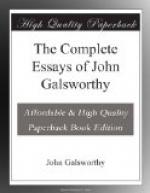A false phrase, a single word out of tune or time,
will destroy that illusion and spoil the surface as
surely as a stone heaved into a still pool shatters
the image seen there. But this is only the beginning
of the reason why the naturalistic is the most exacting
and difficult of all techniques. It is easy enough
to reproduce the exact conversation and movements of
persons in a room; it is desperately hard to produce
the perfectly natural conversation and movements of
those persons, when each natural phrase spoken and
each natural movement made has not only to contribute
toward the growth and perfection of a drama’s
soul, but also to be a revelation, phrase by phrase,
movement by movement, of essential traits of character.
To put it another way, naturalistic art, when alive,
indeed to be alive at all, is simply the art of manipulating
a procession of most delicate symbols. Its service
is the swaying and focussing of men’s feelings
and thoughts in the various departments of human life.
It will be like a steady lamp, held up from time
to time, in whose light things will be seen for a
space clearly and in due proportion, freed from the
mists of prejudice and partisanship. And the
other of these two main channels will, I think, be
a twisting and delicious stream, which will bear on
its breast new barques of poetry, shaped, it may be,
like prose, but a prose incarnating through its fantasy
and symbolism all the deeper aspirations, yearning,
doubts, and mysterious stirrings of the human spirit;
a poetic prose-drama, emotionalising us by its diversity
and purity of form and invention, and whose province
will be to disclose the elemental soul of man and
the forces of Nature, not perhaps as the old tragedies
disclosed them, not necessarily in the epic mood,
but always with beauty and in the spirit of discovery.
Such will, I think, be the two vital forms of our
drama in the coming generation. And between
these two forms there must be no crude unions; they
are too far apart, the cross is too violent.
For, where there is a seeming blend of lyricism and
naturalism, it will on examination be found, I think,
to exist only in plays whose subjects or settings—as
in Synge’s “Playboy of the Western World,”
or in Mr. Masefield’s “Nan”—are
so removed from our ken that we cannot really tell,
and therefore do not care, whether an absolute illusion
is maintained. The poetry which may and should
exist in naturalistic drama, can only be that of perfect
rightness of proportion, rhythm, shape—the
poetry, in fact, that lies in all vital things.
It is the ill-mating of forms that has killed a thousand
plays. We want no more bastard drama; no more
attempts to dress out the simple dignity of everyday
life in the peacock’s feathers of false lyricism;
no more straw-stuffed heroes or heroines; no more rabbits
and goldfish from the conjurer’s pockets, nor
any limelight. Let us have starlight, moonlight,
sunlight, and the light of our own self-respects.
1909.




